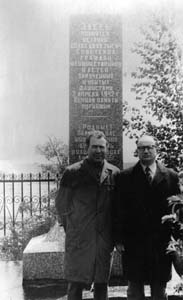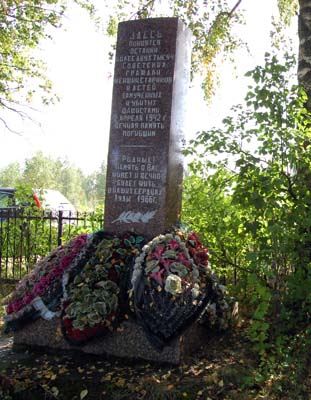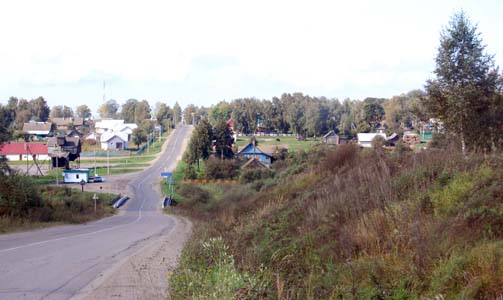

Project «Voices of Jewish settlements. Vitebsk region.»פיתוח קשרי התרבות בין העמים של ישראל ובלרוס
|
|---|
Website search |
|
MainNew publicationsContactsSite mapVitebsk regionMogilev regionMinsk regionArkady Shulman
|
KEEPING THE MEMORIESAt the end of the 80s, when the Soviet authorities lifted a ban on learning Jewish history and culture, Liady became increasingly visited by people, who were interested in the subject. They attempted to find the traces of “the lost civilization” in this former Jewish shtetl. L. Erenburg – to the right
L. Erenburg – to the rightwith Liady ghetto prisoner V. Lesnikov. Photo taken in 1968. Naturally, they first contacted Lev Solomonovich Erenburg, the only Jew in Liady and a historian on top of that. He used to teach history at school and eagerly responded to requests of all the guests. He toured them around the town describing and showing everything. The guests willingly photographed cemetery tombstones, matseivas, which were piled up near a well. People would put full and empty buckets on them. The water spilled and washed the old stones, which revealed inscriptions, which summarized the life of some Liady dweller. While walking around Liady many people asked Lev Solomonovich to share facts from his biography. He was not the one who enjoyed talking about himself, so he replied briefly: “I was born in Kopyl. In 1940 I entered the political-economic department of Leningrad State University. On June 22nd, 1941 I volunteered to go to the battlefront. On September 17th, 1941 I was seriously wounded.” He was declared dead by mistake, however he survived. After being in hospitals he returned to the Army in 1943 and took part in battles in the Crimea. After the Victory in 1945 Lev Solomonovich found out the terrible truth: his parents, younger brother and sister had been shot by Nazis in Kopyl. Only the elder sister Anna Solomonovna survived because she had been hidden by Belarusians in Shklov region.  Memorial to executed prisoners of Liady ghetto.
Memorial to executed prisoners of Liady ghetto.Photo taken in 2009. The demobilized soldier Erenburg returned to Leningrad to continue his studies at university in 1949 and graduated with a degree in political economy. That was the time when Stalin started unfolding his anti-Semite campaign all around the country. Lev Solomonovich continued: “When I came to get my job placement, I was told that Jews were not allowed to teach political economy, since they could teach students hostile ideology. So, I was allowed die for the country. The bullet did not ask which ideology I supported. But I was not allowed to teach. I got my diploma without a job placement and was unemployed for a long time. Eventually I found a job of a teacher at a rural school, had my share of travelling around Belarusian villages and finally settled in Liady.” Lev Solomonovich was restless by character – he could not fit his knowledge into the school curriculum limits. Once he said to his students: “Let us organize Liady museum at our school.” The children reacted enthusiastically and started writing letters to people who had lived in Liady before the war. They also contacted their children, grandchildren and friends. And soon they began receiving parcels with photographs and family relics. The museum was becoming a reality and it everyone was satisfied with the results. The students were seriously involved in the studying process and it kept them busy.  Liady. Photo taken in 2009.
Liady. Photo taken in 2009.
Someone from the authorities did not approve of the museum – there were too many Jewish names involved and many photographs had inscriptions in Yiddish. At the time, if a certain period of history was not desirable for the regime, it was simply “eliminated”. So, a special commission was soon sent to the school and they decided to close the museum. The precious photographs and exhibits were first moved from one place to another and later put into bags and locked in a closet. That was another history lesson for the schoolchildren. This, of course, discouraged Lev Solomonovich but he continued writing to the former Liady residents, collecting documents and facts about the life in the shtetl. Unfortunately he did not get the time to publish the collected materials – he died in the middle of the 90s. These materials have been widely used by researchers living in Israel, Russia and Belarus. The place of the former Liady ghetto is now marked with an unpretentious memorial. Every year it used to be visited by relatives and friends of those who had perished. These people almost all stopped at Lev Solomonovich’s small apartment. These days almost no one visits the memorial and the last Jew from liady, Lev Solomonovich, is now gone, too. Arkady Shulman |
|||
|
|
Jewish settlements in Vitebsk regionVitebsk • Albrehtovo • Babinovichi • Baran • Bayevo • Begoml • Beshenkovichi • Bocheikovo • Bogushevsk • Borkovichi • Braslav • Bychiha • Chashniki • Disna • Dobromysli • Dokshitsy • Druya • Dubrovno • Glubokoye • Gorodok • Kamen • Kohanovo • Kolyshki • Kopys • Krasnopolie • Kublichi • Lepel • Liady • Liozno • Lukoml • Luzhki • Lyntupy • Miory • Obol • Oboltsy • Orsha • Osintorf • Ostrovno • Parafianovo • Plissa • Polotsk • Prozorki • Senno • Sharkovshina • Shumilino • Sirotino • Slaveni• Smolyany • Surazh • Tolochin • Ulla • Verhnedvinsk • Vidzy • Volyntsy • Yanovichi • Yezerishe • Zhary • Ziabki • |
Main |
New publications |
Contacts |
Site map |
Vitebsk region |
Mogilev region |
Minsk region |